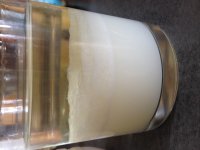DiMoiTou
Rising Star
Hi guys!
Yesterday, I was browsing through my goodies' stash and saw that my DMT wasn't as white as it used to be. I should have stored it in glass rather than cheap permeable plastic bag...
Anyway, I remembered about the zinc process to convert NMT back to DMT, so I thought I should give it a go.
I had two bags of DMT, same weight more or less, but not looking the same.. one was more flaky silvery pinkish and the other more pasty yellowish.
I poured each bag in a glass, covered in Hcl and added same weight of Zinc powder.
Stirred a bit and let it rest for the night.
And now, the two liquids don't look alike. One is clear while the other isn't. The cloudy one contained some yellowy orange stuff when I checked this morning. It dissolved/disappeared when I stirred.
My question is: have I done something wrong? Should I proceed in a different way from now on?
Perhaps one of the bags contained freebase and the other fumarate... Labels have faded, for I haven't touched the stuff in two years or so...
Thanks for your help!
Yesterday, I was browsing through my goodies' stash and saw that my DMT wasn't as white as it used to be. I should have stored it in glass rather than cheap permeable plastic bag...
Anyway, I remembered about the zinc process to convert NMT back to DMT, so I thought I should give it a go.
I had two bags of DMT, same weight more or less, but not looking the same.. one was more flaky silvery pinkish and the other more pasty yellowish.
I poured each bag in a glass, covered in Hcl and added same weight of Zinc powder.
Stirred a bit and let it rest for the night.
And now, the two liquids don't look alike. One is clear while the other isn't. The cloudy one contained some yellowy orange stuff when I checked this morning. It dissolved/disappeared when I stirred.
My question is: have I done something wrong? Should I proceed in a different way from now on?
Perhaps one of the bags contained freebase and the other fumarate... Labels have faded, for I haven't touched the stuff in two years or so...
Thanks for your help!




